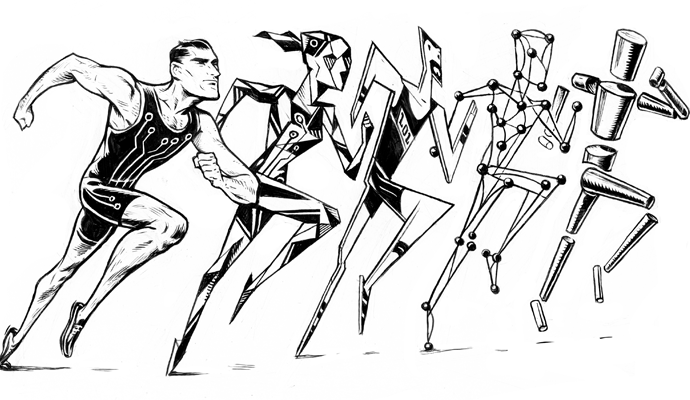How to pick technology winners
Some of today’s innovations will become as prevalent as smartphones. Others, such as jet packs, won’t take off. Three factors can help you tell which are likely to succeed.
Google’s fleet of autonomous cars have logged more than 10 million miles on public roads. The manufacturing industry has more than 2 million robots in operation worldwide. And two out of five people now use voice search daily.
Not so long ago, these technologies were the stuff of science fiction. Now they're everyday reality. Nonetheless, the likes of jet packs, anti-aging pills, and warp-speed space travel aren’t coming any time soon.
As the Fourth Industrial Revolution takes hold, how can we predict which futuristic technologies will become a reality — and have a real impact on our lives and businesses — and which will become memories from 30-year-old sci-fi movies?
Welcome to the world of technology futurists like me. I can’t claim to be 100 percent accurate with my predictions, but I have had some successes. For example, I consulted on Minority Report, the 2002 Steven Spielberg film that was set in a world with gesture-based computing, facial recognition, personalized advertising, and self-driving cars — years before those technologies became a reality.
Making accurate predictions is personally satisfying, to be sure. But on a more pragmatic level, imagine the advantages you or your company could have enjoyed if you had forecast the mass adoption of smartphones. Given the disruptive impact of new technologies, a business leader who can predict tech winners will gain a huge competitive head start.
Three key factors
It’s not easy to make tech-related predictions. Just as Michael Porter’s Five Forces Framework involves assessing a handful of forces to analyze business competition, technology forecasting requires examining three key factors and how they interrelate:
- The context in which the technology emerges
- The viability of the technology
- The barriers to the technology’s success
The context includes current global political and economic forces. It’s hard to imagine nuclear power being developed so quickly without the impetus of World War II, for example, which spawned the Manhattan Project. Microeconomic factors, such as existing infrastructure, can also make or break a technology, or delay its success. For example, an enormous amount of venture capital went into clean energy technologies in the early 2000s, yet it took a long time for these technologies to take hold in a significant way. Early investors discovered the hard way that you can’t just overturn an entrenched power distribution system overnight.
An enormous amount of venture capital went into clean energy in the early 2000s; investors discovered the hard way that you can’t just overturn an entrenched power distribution system overnight.
The technology itself also has to be viable. Jet packs aren’t likely to be feasible in the near future because it’s impossible to defy the laws of physics.
Finally, the technology’s potential barriers to success must be considered. Regulations and incumbent competitors are obvious hurdles. Where businesses dominate a market with their marketing or distribution power, a new technology has to be extremely good or desirable if it is to displace them. In some instances — such as Amazon in retail and ride-sharing companies in transportation — the failure of incumbents to harness new technologies has allowed startups to disrupt them.
The destiny of digital assistants
With these fundamentals of technology predictions in mind, let’s examine the evolution of digital assistants such as Amazon’s Alexa, Apple’s Siri, and Google Assistant. These devices promise to make our lives easier by using artificial intelligence (AI) to respond to our voice commands and perform tasks for us. If tech companies have anything to do with it, digital assistants will soon be everywhere, including offices, hotel rooms, and every room of the house — even in toilets.
Indeed, smart speakers that incorporate digital assistants are finding their way into more and more homes. Global shipments reached 19.7 million in the third quarter of 2018 — an increase of 137 percent from the previous year, according to technology research firm Canalys. To figure out how far this technology will spread, let’s look at digital assistants in light of our three factors:
1. The context: How do digital assistants fit our world? Digital assistants represent a solution to two modern societal problems. First, daily life has become highly complex. Every mobile app, online form, ATM, and self-service kiosk that we use requires multiple interactions. We’ve filled our lives with more ways to communicate and socialize, and more types of entertainment. The second problem is time — we just don’t have enough of it, in part (and somewhat paradoxically) because we’ve filled our lives with so many activities.
Digital assistants can help with both these problems. They can help us manage complexity by making mundane tasks quicker and easier, saving time and enabling us to become more productive. Google Assistant, for example, can call restaurants and make reservations, and it can even have a voice conversation with a restaurant’s employee.
If using these assistants results in our having fewer tasks and distractions, we’ll be able to focus more on the important things in our lives and become more effective. And digital assistants also will help us with many mundane tasks at work, such as scheduling meetings or automatically relating meeting notes to associated records such as accounts, contacts, and cases.
Although today’s digital assistants offer limited functionality, future iterations will be the full-time partner of many people at work, at home, at school, in the doctor’s office, and elsewhere. The digital assistant will be one of the primary vehicles for engagement with the world, and certainly with every digital system.
2. The technology: Does it work? Digital assistants have come a long way since 2016, when Amazon introduced Alexa. The company’s underlying technologies — speech recognition, machine learning, and conversational AI — have made huge strides. However, studies of how people currently use digital assistants suggest that either the technology or our understanding of it is still relatively immature. Possibly both.
According to a U.S. survey by Adobe, the most popular uses of smart speakers are playing music (70 percent), providing weather forecasts (64 percent), and answering “fun questions” (53 percent), hardly the most sophisticated uses for an AI-driven application.
But the potential is enormous. Even today’s digital assistants are capable of understanding personal preferences and triggering a series of actions. For example, you can set up an Alexa, Siri, or Google Assistant so that when you tell it you are home, it automatically resets the thermostat, turns on lights and your preferred audio program, plays back your voicemails, and sends a text message to your spouse.
In the future, your digital assistant could automatically and seamlessly handle everyday tasks, integrating your connected appliances, autonomous car, and other devices to do your shopping for you and get you to your appointments. It could interact with other systems, such as facial recognition in stores. For example, a retailer’s AI-driven system could recognize you when you walk in, offering products based on your preferences and interacting in the background with your digital assistant. And it would automatically make the payment transaction when you walk out.
A digital assistant could help you by offering motivating suggestions to help you stay fit and healthy. It could help you throughout the workday by automatically connecting with colleagues and finding documents relevant to the task at hand.
3. The barriers: Will sales growth continue? The AI, voice processing, and other technologies underlying digital assistants are improving every year, and will need to continue doing so for them to reach their full potential. Devices that enable voice interaction with users, including smart speakers, will also need to evolve.
But assuming the technology is only a temporary hindrance to growth, what are the potential longer-term barriers to success?
First is privacy. With smart speakers, consumers are essentially being asked to trust a device that sends audio from their home to a tech giant’s systems in the cloud. This is at a time when consumers increasingly distrust businesses over how they use data.
Second is inertia. Customers need a certain level of service, convenience, and price compression before widespread adoption happens. Gartner’s hype cycle, in which new technologies generally navigate a long “trough of disillusionment” after early adoption and before widespread consumer adoption, invokes this phenomenon. (Incidentally, digital assistants are just now falling into that trough, according to Gartner’s August 2018 edition).
But that inertia is a temporary obstacle. The third, and most considerable, impact on the future development of digital assistants is resistance from incumbency — more specifically, the vested interests of all businesses in owning their relationship with their customers.
The leaders in providing digital assistants right now are Amazon, Apple, and Google. But companies that value the direct relationships they’ve built up with customers will not easily acquiesce to being disintermediated by a technology company in a world where we’re routinely told that “data is the new oil.” J.P. Morgan rolled out a digital assistant for corporate payments recently. Starbucks unveiled its own chatbot in 2017. They’re two of many.
What will it mean for brands if the tech giants dominate AI-powered voice-activated search, commerce, entertainment, home appliances, and office assistants? How will companies adapt if their customers do everything via digital assistants — including ordering goods and services — and the businesses lose their ability to interact directly with customers?
There are three radically different industry-dynamic models for how this could develop. One model is that the big players — Amazon, Google, Apple, Alibaba, Baidu, Tencent — will own the relationship. In this model, if I am an Amazon devotee, I will choose to use Alexa for everything.
The second model is similar to how people use smartphones today. They have a work version and a personal version. In this model, perhaps at home, Alexa is my assistant. But my work assistant might be a different one, chosen by and provided by my employer.
The third model is more fragmented. In this version of the future, a number of service enterprises — banks, retailers, long-term healthcare providers — offer their own particular virtual assistants. Citibank might introduce a digital financial guide, Kaiser Permanente might put forth an electronic healthcare aide, and Netflix might provide an entertainment concierge. Perhaps these specialized assistants would then connect to a higher-level, general assistant provided by Amazon, Google, or other dominant players.
It is unclear which of these three models will take hold. At Salesforce, we’ve tested this question at some length with a variety of customers and developers, and we get a multitude of answers. Right now, it appears to be an open game. If history is any guide, it will come down to a few giants dominating the field, but the power of individual providers — such as banks and healthcare providers — is also very great. The evolution of the digital assistant is going to be one of the most interesting developments to watch in the marketplace for the next five years.
Identifying the tipping point
The holy grail of tech forecasting is predicting the likelihood and timing of the tipping point between a technology remaining an optional product for most consumers and it becoming a must-have.
For digital assistants, that could happen as more household devices become electronically controlled. If that trend continues, it’s likely that we will soon reach a point when it becomes essential to have a digital assistant that integrates all these devices. Then, having conquered the home, digital assistants could evolve to help us control the rest of our world.
By my estimation, today’s digital assistant is probably equivalent to the BlackBerry in its heyday — cool and useful, but offering only a fraction of the utility value of the yet-to-be-released iPhone. Based on analysis of the three key factors, I’m confident that sophisticated, app-enabled digital assistants will soon exist — and will affect our lives and businesses as much as, if not more than, today’s smartphones.
Nonetheless, I could be wrong. Picking tech winners early is hard, even for futurists. However, leaders willing to go through this process and educate themselves about new technologies using the three key factors detailed above are likely to spot trends earlier, encounter fewer surprise disruptions, and take the best course of action at the right time. And isn’t that what distinguishes the best business leaders?
Author profile:
- Peter Schwartz is a noted futurist and senior vice president of strategic planning at Salesforce. His books include The Art of the Long View: Planning for the Future in an Uncertain World.




